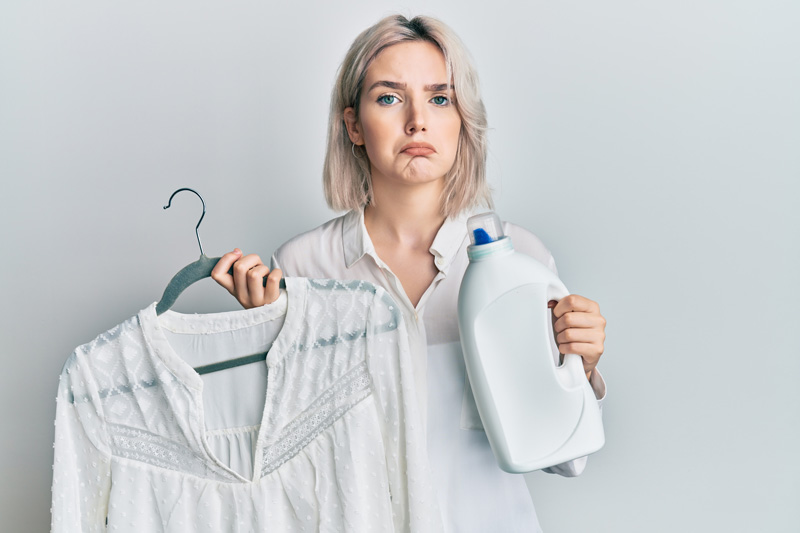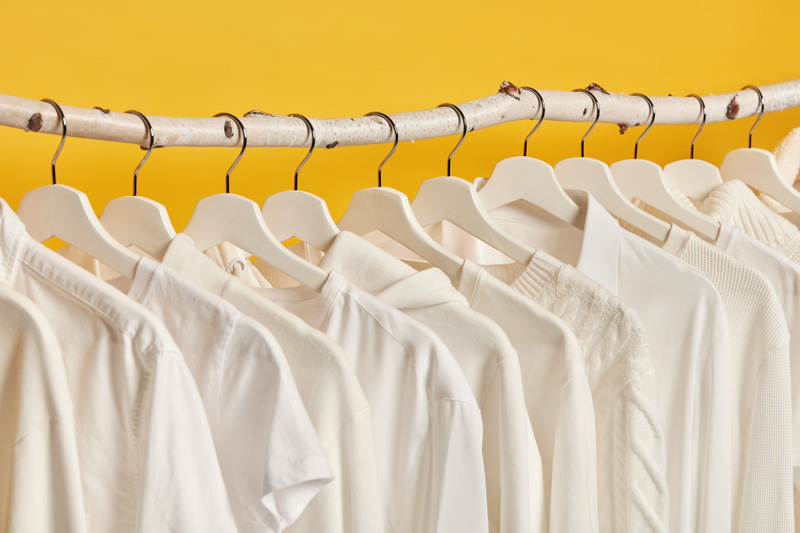
Image by krakenimages.com on Freepik
Mastering how to wash white clothes can revive the brightness in your fabrics and extend their life. With the right approach, you can separate your whites from colored clothes and wash them at the appropriate temperature to prevent any mishaps. It’s crucial to use the hottest water that’s safe for the fabric, handle stains with care before washing, and ensure your washing machine isn’t overloaded for the cleanest results.
In navigating the process of how to wash white clothes, considering what temp to wash whites and the right white clothes wash temperature becomes key. From treating your garments with oxygen-based stain removers to employing a heavy-duty detergent with optical brighteners, each step plays a crucial role. Adding distilled white vinegar to the rinse cycle can strip away residue detergent, ensuring your whites come out pristine every time.
Understanding Fabric Types
Understanding the types of fabrics you’re dealing with is crucial when learning how to wash white clothes. Here’s a quick guide:
- Sturdy Fabrics:
- Cotton, Jeans, Towels, and Manmade Fibers: Wash in warm water to effectively remove dirt and stains.
- Care Tip: For cotton, treat stains immediately and use hot water with mild soap. Tumble dry using warm air.
- Delicate Fabrics:
- Silk, Lingerie, Spandex, and Activewear: These should always be washed in cold water to preserve the fabric’s integrity.
- Care Tip: Silk garments require hand washing or a very mild machine wash in cool water. Remove immediately to prevent wrinkles and air dry or tumble dry on a cool setting.
- Special Fabrics:
- Wool: Hand wash in cool to lukewarm water and lay flat to dry. Avoid heat to prevent shrinking.
- Rayon: Hand-wash in cold water with mild detergent. Air dry and iron when slightly damp.
- Cashmere: Preferably dry-clean. If hand-washing, use baby shampoo and fold to maintain shape.
Each fabric type demands specific care to maintain its whiteness and integrity. Always check the garment’s care label before proceeding with washing.

Image by wayhomestudio on Freepik
Using Baking Soda
To harness the whitening power of baking soda in your laundry routine, follow these actionable steps:
- Boosting Detergent Performance:
- Add ½ cup of baking soda directly to the washing machine drum before adding clothes, detergent, and water.
- For larger loads, increase the amount to a full cup to ensure thorough cleaning.
- Enhancing Bleach Effectiveness:
- Combine baking soda with your regular bleach or detergent to regulate the pH level of the water.
- This combination makes bleach work more effectively and boosts the overall performance of the detergent.
- Pre-Treatment for Stains:
- Create a paste using baking soda and a small amount of water. Apply this paste directly to acidic stains such as coffee or fruit juice, and let it sit for 30-60 minutes before washing.
- For stubborn stains, soak clothes in a mixture of warm water and one cup of baking soda for up to eight hours before washing as usual with your preferred detergent.
By integrating baking soda into your laundry routine, you’re utilizing a natural and non-toxic method to achieve brighter whites and effectively tackle stains[11].
Leveraging the Power of Distilled White Vinegar
Distilled white vinegar is not only a kitchen staple but also a powerful tool in your laundry arsenal. Here’s how to leverage its power effectively:
- Stain Removal: For low-pH stains such as coffee, tea, and wine, soak the stained garment in a solution of white vinegar and 1 Tbsp. liquid laundry detergent for at least 30 minutes up to overnight before laundering. This pre-treatment helps in breaking down the stains, making them easier to wash out.
- Odor and Buildup Removal: Adding 1/2 to 1 cup of vinegar to the last rinse cycle can do wonders by removing odors and stripping away detergent buildup from your clothes. This is particularly useful for towels, which can often retain a musty smell even after washing. Remember, vinegar should not be mixed with chlorine bleach or products containing chlorine bleach due to the risk of harmful fumes.
- Fabric Care: Vinegar acts as a natural fabric softener and can prevent pet hair and lint from clinging to clothes. However, it’s important to use it judiciously. Overuse, especially on gym gear or clothing with elastic, can lead to damage due to its acidity. For a machine clean, run an empty wash cycle with hot water and 2 cups of distilled white vinegar to keep your washer in top condition.
The Natural Whitening Effects of Lemon Juice
Leveraging the natural bleaching properties of lemon juice can significantly enhance the whiteness of your clothes, making it a viable and eco-friendly alternative to chemical bleaches. Here’s how you can incorporate lemon juice into your laundry routine:
- Pre-Treatment Solutions:
- For general stain removal, dilute one-third cup of lemon juice in two-thirds cup of water and soak the stained area before washing.
- Tackle rust stains by soaking the affected area with lemon juice and sprinkling cream of tartar or salt before rubbing the solution into the stain.
- Create a paste with lemon juice and salt to address mold and mildew on fabrics, applying directly to the affected area.
- Enhancing Wash Cycles:
- Add one-quarter to one-half cup of lemon juice to the wash cycle in place of bleach for a natural whitening effect, particularly effective on cotton and polyester fabrics.
- For stubborn stains or to achieve a stronger bleaching effect, soak whites in a mixture of one-half cup lemon juice to a gallon of hot water for at least an hour or overnight.
- Post-Wash Brightening:
- Utilize the sun’s natural bleaching effect by washing clothes as usual, adding up to ½ cup of lemon juice for an extra whitening boost, and drying them in direct sunlight.
- For immediate stain treatment, mix lemon juice with water and spray directly onto stains before sun bleaching.
Incorporating these steps into your laundry routine can help maintain the brightness of your white clothes without resorting to harsh chemicals, while also leaving a subtle citrus scent.
Harnessing Sunshine for Whitening
Harnessing the power of sunshine for whitening your white clothes is both an effective and eco-friendly method. Here’s how to do it right:
- Preparation:
- Wet your clothes before laying them out, as the sun’s bleaching effects are more potent on damp fabrics.
- Spread the clothes as flat as possible to ensure even exposure to sunlight. This helps in achieving uniform whiteness across the fabric.
- Duration and Care:
- Typically, two to three hours of sunlight are sufficient for effective bleaching. However, thicker materials like terrycloth towels may require longer exposure.
- Be cautious not to overdo it. Leaving clothes out for too long can weaken the fabric. It’s advisable to check the progress periodically and remove the items once they’ve reached the desired level of whiteness.
- Versatility and Benefits:
- This method is not limited to clothes; it can also remove stains from other items like plastic toys.
- Sun bleaching is a safer alternative to chemical bleaches, making it suitable for those with sensitive skin or environmental concerns.
- Additionally, drying clothes in the sun helps kill bacteria and cuts down on electricity usage, contributing to a healthier home and planet.
By following these simple steps, you can effectively use sunlight to keep your white clothes bright and fresh, while also embracing a more sustainable laundry routine.
Hydrogen Peroxide: A Safe Bleach Alternative
Hydrogen peroxide offers a safe and environmentally friendly alternative to traditional bleach for keeping your clothes, especially white fabrics, looking their best. Here’s how you can incorporate it into your laundry routine:
- Brightening Whites and Colors:
- To whiten dingy whites, add 1 cup of hydrogen peroxide to the washer drum before adding water and clothes.
- For colored clothes, add 1 cup of hydrogen peroxide to the bleach dispenser to brighten them without fading.
- Stain Removal and Washer Maintenance:
- Directly apply a small amount of hydrogen peroxide on stains, let it soak for 10 minutes, then wash as usual to remove stains from clothes.
- Clean and disinfect your clothes washer by adding 2 cups of hydrogen peroxide to the empty washer drum and running a hot water wash cycle.
- Safety and Environmental Benefits:
- Hydrogen peroxide is non-toxic, non-corrosive, and biodegradable, making it safer for skin, lungs, and the environment compared to chlorine bleach.
- Always test on an inconspicuous spot for colored clothes to ensure colors don’t fade and never mix with ammonia, vinegar, or chlorine bleach to avoid toxic gases.
By following these guidelines, you can effectively use hydrogen peroxide as a versatile laundry aid that not only cleans but also disinfects and deodorizes your clothes.
Conclusion
Through the exploration of various methods for washing white clothes, we’ve unveiled a plethora of effective strategies to maintain and enhance the brightness and longevity of our most cherished fabrics. From employing the right temperatures and detergents to utilizing household staples like baking soda, distilled white vinegar, lemon juice, and harnessing the natural bleaching power of sunshine, each technique offers a unique approach to tackle the challenges of keeping whites pristine. Additionally, the safe and environmentally friendly alternative of hydrogen peroxide not only underscores the importance of sustainable practices but also highlights the shift towards more gentle, yet effective, cleaning solutions.
The significance of understanding fabric types and the specific care they require cannot be overstated, as it ensures that our whites remain vibrant without compromising their quality. This journey through the myriad of laundry aids not only reinforces the importance of meticulous care in fabric maintenance but also invites further exploration and adoption of eco-friendly practices in our daily routines. As we strive for whiter whites, let’s also aim for greener, more sustainable laundry habits that benefit both our clothes and our planet.
FAQs
Q: What methods can I use to restore the brightness of my white clothes?
A: To revive the brightness in your white clothes, consider using whitening agents such as oxygen bleach or bleach alternatives like baking soda or vinegar. It’s important to check the laundry care label on each garment to ensure you won’t cause any damage.
Q: What are some effective ways to make white fabric look brighter?
A: There are several methods to brighten yellowed white clothes, including:
- Baking Soda: It helps to remove soil from cotton clothing.
- Distilled White Vinegar
- Lemon Juice
- Citric Acid Powder
- Borax Powder
- Bluing
- Color Remover
- Hydrogen Peroxide
Q: What is a good technique for washing white clothes to make them brighter?
A: To enhance the brightness of white clothes, add half a cup of white vinegar to your wash, which can help remove grey or yellow tints from the fabric. Alternatively, using a half cup of oxygen bleach can achieve similar results.
Q: How can I make my dingy white clothes look bright again?
A: To whiten and brighten laundry that has become dingy, you can use:
- Bleach
- Bluing Liquid
- Enzyme Presoaks
- Lemon Juice
- Sodium Bicarbonate (Baking Soda)
- Sodium Borate (Borax)
- Sodium Carbonate (Washing Soda)
- White Distilled Vinegar
References
[1] – https://www.thespruce.com/how-to-keep-white-clothes-white-2146392
[2] – https://www.mollymaid.co.uk/2013/06/19/let-the-sun-in-how-to-naturally-bleach-out-stains-on-clothes/
[3] – https://www.youtube.com/watch?v=NvVdCEZ_3M0
[4] – https://www.wikihow.com/Wash-White-Clothes





